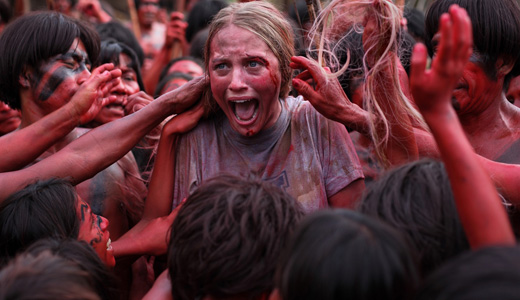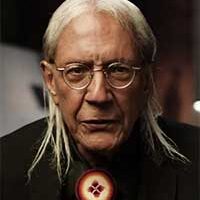
I thought that new lows in extreme, flagrantly racist portrayals of the Indigenous peoples of North and South America were an anachronism – a step back in time which no filmmaker would again dare traverse. How wrong can one be?
Filmmaker Eli Roth, who specializes in the horror genre, has no problem time traveling in the wrong direction. His latest offering, or in this case, cinematic atrocity, made its debut with “The Green Inferno.” After viewing it (parts of which left me momentarily speechless) I gathered my wits to write a review.
The story is about a group of well-meaning, idealistic college students who are enticed by a campus activist intent on pulling a public relations expose to aid an Indigenous Brazilian tribe whose lands are being invaded by money-hungry logging developers. To make this part of the long story short: Most of the students end up being eaten by those they sought to assist.
The Indian people are reduced to such a level of beastly subhumanness that I found myself actually, unconsciously mentally rooting, at some points, for the developers to wax victorious.
At the end of this movie experience, nobility passes to a young white woman, who stops the slaughter of the Natives with a cell phone camera, photographing the carnage, and later expounds about how well she was treated by the Indigenous hosts who devoured her fellow activists.
All that was missing from this walk back in cinematic time was a resurrection of Johnny Weismuller from the grave to swing through the trees playing Tarzan. Just replacing the mythical hungry-for-human-flesh Indians with the Indigenous of Africa would have added the final touch.
How many otherwise well-meaning white people and others will believe that many Amazon peoples are not actually cannibal, especially those that are classified as “uncontacted.” According to Brazilian government sources there are over 67 tribes in the Amazon that are listed as “uncontacted.” This is a bit of a misimpression because many of the tribes considered “uncontacted” are in fact descended from Native peoples who retreated, centuries ago, into the fastness of the Amazon region in the face of the European invasion in the so-called “Age of Discovery.”
Many of the Indigenous peoples living in the Amazon originally lived on the Atlantic Coast. Others of the “uncontacted” are descendants of the survivors of 20th century assaults by loggers and the rubber boom and have made a conscious decision to have no further contact. They are exercising their right to self-determination.
There is a lingering stereotyped impression some have of the Amazon peoples. When I mentioned recently to a white friend of long standing that I had been invited by an environmental land rights organization, to meet with the Indigenous peoples to write a story, his first comment was that I might end up with a “shrunken head.” This type of film only reinforces such concepts.
Eli Roth wanted to make a horror film. The true horror that is ongoing is the hideous, abominable genocide that has been perpetrated against the Native people of Brazil, from the 16th through the 21st centuries.
A few examples will suffice to show that the genocidal crimes against humanity committed in 19th century California against Native people, as I wrote in an earlier column, were still being committed against Indian people in the 20th century in Brazil .
The Figueiredo report of 1967 detailed shocking atrocities committed against Brazilian Indians in the 1940s, ’50s and ’60’. This study resurfaced recently – 45 years after it was supposedly destroyed in a fire.
One of the accounts cited in the report describes the 1963 “massacre at the 11th parallel,” where dynamite was thrown from a plane onto a village of Cinta Larga Indians. Only two survived.
Other atrocities included the poisoning of hundreds of Indigenous with sugar laced with arsenic. Severe methods of torture were also used such as slowly crushing the victims’ ankles with an instrument known as the “trunk.”
The 7,000-page document details mass murder, torture, sexual abuse, enslavement and bacteriological warfare conducted against Brazil’s Native peoples. Many were completely wiped out during this era of the 20th century.
This is what mammon-mad capitalism has meant to Native people throughout the length and breadth of the Western Hemisphere – genocide, suicide, bestial torture, sadistic institutionalized murder, lives of unremitting misery with the grim, gory specter of utter annihilation always looming on the horizon.
There is one image of Brazil, from the 1970s, that is forever seared into my memory. This was from the Native newspaper, Akwesasne Notes. It was of a mostly nude, Brazilian Indian woman hanging upside down by her feet. The caption said that her baby had its head shot off and that her captors killed her by cutting her in half with a machete.
To further indicate the attitude of some racist Brazilians toward Indigenous people I must relate an account, from the 1990s, of a good friend of mine, an internationally known American Indian poet. She was flying back to the U.S. from Brazil and sitting behind her were a group of American and Brazilian businessmen. They were discussing hunting. She overheard one of the Brazilians remark, “Brazil is one the few countries where you can still hunt Indians.” This is the true horror that exists in Brazil.
Another bone I have to pick with this hideous film is in reference to the only Black character, an African American student, in the university group. He is the first member of the sortie to be killed and eaten. His demise is the most grotesque of any of the students. I could not help but note that going back to the early days of America cinema, the African American was always the first to “bite the dust.” Needless to say this is indicative of the hold of racism on the film industry even to this present day.
Sadly, Roth took the low, ultra-racist road in the cinema. We in the Native community want to see this monstrosity consigned to the junk heap of film history never again to raise its racist head.
Photo: AP










